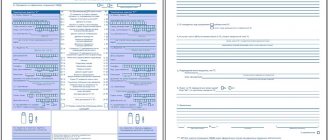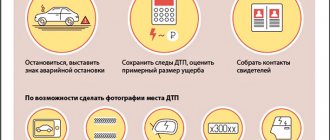The civil liability protection agreement clearly states that this document is aimed at covering damage to third parties injured as a result of an accident that occurred due to the fault of the policy owner. This includes expenses not only for repairing the damaged car, but also for treating injuries received by the injured party during the accident. The amount of compensation for specific injuries provided for by the RSA regulations will be shown by the unified table of payments under compulsory motor liability insurance for injury to health, which we will read in the article below.
Briefly about OSAGO
OSAGO is a temporary form included in the list of documents required for driving vehicles. Unlike CASCO, its competence covers only one insured event - a traffic accident involving two or more cars. But compensation under the said agreement may be intended exclusively for the affected persons. The owner of the policy himself does not receive any financial compensation for vehicle repairs or restoration of health under the auto insurance policy.
Depending on social
category and actual condition of victims of road accidents who suffered harm to health, the amount of payment under compulsory motor liability insurance will range from 5 to 500 thousand rubles. But for movable property this limit does not exceed 125,000 rubles for one damaged vehicle, and 160,000 rubles for two or more damaged vehicles.
In addition, movement on public roads without a mandatory insurance policy on the territory of the Russian Federation is punishable by law. For the first time, the lack of insurance will entail liability for the driver in the form of a fine of 500 rubles. Well, subsequent disregard of the rules may result in his arrest for a period of 3-6 months.
Double accident
So, in December 2021, a certain MAZ driver drove into oncoming traffic at the 450th kilometer of the Dzerzhinsk - Nizhny Novgorod road and crashed into an oncoming LADA Niva. As a result of the accident, Niva passenger Kalinkina was seriously injured. Let us remind you that under compulsory motor liability insurance passengers or injured pedestrians can count on compensation for damage to health up to 500 thousand rubles. In this case, the compensation itself is calculated using special tables. Each injury has its own price - as a percentage of the maximum payment.
Both drivers had civil liability insurance, and from the same large company. Therefore, the woman turned to the insurer for payment.
The insurer paid her a total of 187,750 rubles. But under one OSAGO agreement. For the MAZ driver who caused the accident. Under the Niva driver's insurance, the insurer refused to pay out, not recognizing the case as insured.
Then the woman went to court. However, the courts of first instance and then the appellate courts rejected the claim. They referred to the fact that there are no legal grounds for collecting funds under each MTPL agreement.
However, the Supreme Court did not agree with this position. He recalled that, according to Article 1079 of the Civil Code, legal entities and citizens whose activities involve an increased danger to others are obliged to compensate for damage caused by a source of increased danger. At the same time, the owners of such sources, which include cars, are jointly and severally liable for damage caused to third parties as a result of the interaction of these sources. That is, roughly speaking, in the event of a collision between two cars, both drivers pay for the damage caused to passengers, regardless of their degree of guilt.
“Since the insured event under the MTPL agreement is the onset of liability of the owner of the vehicle, then when harm is caused to third parties by the interaction of vehicles, when, by virtue of paragraph 3 of Article 1079 of the Civil Code, liability arises for each of the owners, there is not one insured event, but an insured event for each MTPL agreement,” the Supreme Court indicates in its ruling.
Moreover, the Supreme Court clarified that for damage to health under each MTPL agreement, compensation is paid in full according to the law. The calculation cannot be divided in half if two insured cars collide. And compensation for material damage to third parties is paid jointly and severally.
You will have to overpay for an MTPL policy after an accident in which the driver was not to blame for another five years. After all, he was driving a high-risk vehicle
It also doesn't matter that both drivers are insured by the same company. Two insured events - two payments.
The Supreme Court also recalled that this position was set out in the review of judicial practice approved by the Presidium of the Supreme Court in 2012. It was also confirmed by the resolution of the Plenum of the Supreme Court in 2021.
It is clear that such a decision by the Supreme Court is only for the benefit of passengers injured in road accidents. And the relatives of the victims will generally be able to count on 475 thousand rubles from each driver involved in the accident, that is, receive double or even triple compensation.
By the way, let us explain why 475 thousand and not 500. In the law on compulsory motor liability insurance, compensation in the event of death in the amount of 500 thousand rubles is divided into two parts. 475 thousand is the compensation itself, and 25 thousand are funeral expenses. So, funeral expenses are material damage that insurers will pay jointly.
However, this all seems rather unfair for the driver, who was not at fault for the accident. After all, in the end, the cost of the MTPL policy will increase for him. It's all about the bonus-malus coefficient, which is assigned for an accident-free experience. But this, as they say, is “failure-free”; in fact, this means the presence or absence of insurance claims.
So, a person drove for ten years without getting into an accident, reached the 13th grade, that is, he received a coefficient of 0.5. This is half the cost of the policy. And then, standing at a traffic light, some racer crashed into him, and even with a passenger on board.
Everyone admits the driver's guilt. The insurer pays for the repair of the damaged car for this racer. But then this respectable driver goes to renew his MTPL policy, and he is given the 7th class bonus-malus coefficient, that is, a coefficient of 0.8. And he will have to overpay for the policy after an accident for which he was not to blame for another five years. And his only fault is that he was driving a high-risk vehicle.
It is noteworthy that there is another injustice inherent in this situation. A car passenger can receive compensation that is two or even three times greater as a result of an accident. Depending on the number of cars involved in the accident in which he was injured. Pedestrians cannot count on such generosity. It is unlikely that a pedestrian will be able to get under the wheels of two cars at once. Either he must simply fall onto the road so that two cars can drive over him, or he must be pinched between two cars, one of which is moving backwards and the other forwards. It is clear that these are extremely rare cases.
Thus, passengers of passenger cars in the event of an accident find themselves in a more advantageous position than pedestrians, and even more so, drivers. It is clear that this state of affairs will immediately cause an increase in fraud. It is not without reason that insurers claim that fraudsters have already switched from making money on mechanical damage to the sphere of compensation for damage to life and health. And this legislative issue needs to be resolved somehow. It is likely that amendments will be made to the laws on compulsory motor liability insurance, on insurance, and also, possibly, to the Civil Code.
Compensation for damage to health
In accordance with the RSA regulations, all citizens, without exception, have the right to compensation from the insurance company when injured in an accident, regardless of their status at the time of the accident (driver or passenger). Payments under compulsory motor liability insurance for personal injury in 2021 are calculated based on the following indicators:
- The amount of money spent by the victim on purchasing necessary medications, visiting doctors at the clinic, diagnostic procedures and even a nurse;
- The amount of the wage penalty for the period of rehabilitation of the injured person, if after a traffic accident the loss of ability to work is recorded;
- Costs for the further stay of the accident victim in a sanatorium, if such preventive measures were prescribed by the doctor on the basis of the post-traumatic stress she suffered;
- Costs for purchasing additional equipment (crutches, wheelchair, etc.).
At the same time, the insurance company does not undertake to cover the above-mentioned damage if the injured person was on duty at the time of the accident, since in such situations compensation for damage falls on the shoulders of his employer.
What payments are due?
As we found out earlier, the table of payments under compulsory motor liability insurance can guarantee a maximum limit of half a million rubles, which is provided for the most severe cases. The average damage received by a person in an accident is estimated by insurance companies at approximately 10-20% of the mentioned figure, which in monetary terms reaches 50-100 thousand rubles. But for minor bodily injuries and fractures, a citizen should expect an amount of 250 - 50,000 rubles, depending on the number of injuries and his general health.
How is severity determined?
In accordance with the regulations of the Insurance Company, the following injuries are considered a serious outcome after a traffic accident when compensating for harm to life and health under compulsory motor liability insurance:
- Loss of a limb (jaw, arm, leg, etc.) or any organ (stomach, intestines, part of the lung);
- Burns of III - IV degrees, observed on an area exceeding 4% of the entire skin;
- Spinal fracture (more than 4 links).
Moderate injuries received by a victim as a result of an accident usually include:
- Loss of the front row of teeth (from 7 to 9 pieces);
- Deterioration of hearing or vision;
- Closed and open fractures;
- Loss of one or more fingers;
- Burns of categories I – II, occupying more than 10% of the entire skin.
The table of payments for damage to health under compulsory motor liability insurance includes the following for minor injuries in an accident:
- Cuts and open puncture wounds;
- 1st degree concussion;
- Banal bruises and deep scratches;
- Loss of teeth (up to 3 pieces);
- Minor fractures and burns, the size of which reaches 3-5% of the total area of the skin.
It is worth noting that the last category of injuries occurs most often in practice. But moderate and severe conditions are rare when contacting the Investigative Committee, since the listed degrees of harm are quite difficult to document.
What payments are due in case of injury to health under compulsory motor liability insurance?
So, when third parties were injured as a result of a traffic accident, they are subject to compensation in full within the amount established by the legislator. Additionally, a person may qualify for compensation payments in connection with loss of ability to work or wages during the period of recovery of health
The amount of funds to be paid is established for each case individually, and depends on the degree of harm that was caused to health and the expenses incurred by the injured person.
If the victim as a result of an accident received the status of a disabled person, then the amount of compensation is calculated based on data on the disability group.
In cases where the insurance payment was transferred before a specific diagnosis was made or the degree of harm caused to health was established, the amount must be subsequently recalculated. If necessary, the insurance organization must make an additional payment.
For such categories of proceedings, as a rule, a medical examination is not prescribed. However, in cases where administrative or criminal proceedings are initiated regarding an accident, such examinations are carried out as part of the investigation of the case. As previously noted, if, as a result of the study, the amount of insurance compensation increases, then the insurer cannot refuse the additional payment.
It should also be noted that, depending on the degree of damage the victim received, the culprit may be held liable for various types of liability:
- Civil;
- Administrative;
- Criminal.
In total, there are several categories of types of harm that can be caused to a person as a result of a road accident:
- Moral injury;
- Minor damage to health;
- Moderate harm to health;
- Causing serious harm to a person's health.
To determine what kind of harm was caused in each specific case, there are several criteria to be used:
- The impact of the harm caused as a result of the accident on the life of the person;
- The impact of damage caused to health on the work activity of the victim;
- The period of time during which the person was incapacitated;
- Possibility of maintaining previous work activity after recovery;
- Stopping the functioning of one of the organs or its complete loss.
All of the above criteria are used in the process of conducting a forensic medical examination. Only a specialist can indicate what harm this or that injury caused to the body, and how the injured person’s health will be restored in the future. It is the expert who identifies anatomical and physical damage in the event of a traffic accident, and also assesses the mental state of the injured party.
The list of all criteria that must be used to resolve the issue and the severity of the harm that was caused as a result of a road accident is indicated in Order of the Ministry of Health No. 194.
How to determine the amount of compensation
Having learned to distinguish between three types of injuries in an accident, a citizen can easily find out approximately how much money the company undertakes to compensate him under the contract. The injured party can more accurately calculate the amount of damage using the MTPL payment table below:
| Damage caused to health | Amount of compensation for persons involved in an accident in a private car | Amount of funds provided for passengers of commercial vehicles (in rubles) |
| Disability of the 3rd group | 500000 | 2 000 000 |
| Traumatic brain injuries and nervous system disorders | From 25 to 375 thousand. | From 100 thousand to 1.5 million |
| Visual and hearing impairment | From 25 to 75 thousand. | From 100 to 300 thousand. |
| Respiratory system injuries | From 10 to 300 thousand. | From 40 thousand to 1.2 million |
| Disability of the 2nd group | 350000 | 1 400 000 |
| Damage to the cardiovascular system | From 25 to 150 thousand. | From 100 to 600 thousand. |
| Injuries to the digestive tract | From 5 to 250 thousand | From 20 thousand to 1 million |
| Disorders of the reproductive and urinary system | From 15 to 250 thousand. | From 60 thousand to 1 million. |
| Ligament or soft tissue rupture, burns | From 250 to 250,000 | From 1,000 to 1,000,000 |
| Musculoskeletal injuries, severe fractures and loss of limbs | From 5 to 250 thousand | From 20 thousand to 1 million |
| Complications that arose after a course of therapy | From 25 to 150 thousand. | From 100 to 600 thousand. |
| Poisoning during treatment | From 10 to 75 thousand. | From 40 to 300 thousand. |
| Severe blood loss | From 25 to 50 thousand. | From 100 to 200 thousand. |
| 3rd degree disability | 250000 | 1 000 000 |
It is important to know! If the insurance company refuses to pay the calculated amount of compensation voluntarily, then the injured party reserves the right to file a written claim for compensation for health damage to the RSA or to a local court.
Refund procedure
If you are involved in a traffic accident that results in injuries to third parties (including pedestrians), the person at fault must immediately contact their insurance company and notify them of the tragedy. Further, so that the Investigative Committee does not refuse compensation to injured citizens, the driver is obliged to prepare a package of required documents describing the details of the accident and confirming the condition of the injured people.
After the collected papers are submitted to the agency for consideration, both parties to the conflict will only have to wait for the verdict from the insurers. On average, it takes the insurance company about 3-5 days to calculate the amount for compulsory motor liability insurance and further transfer money to the account of accident victims. The maximum period for carrying out this procedure, in accordance with Art. 12 Federal Law, cannot exceed two weeks. Otherwise, the policy holder has the right to file a complaint against the company’s employees with the RSA or the local judicial authority.
Required documents
In order to receive compensation for damage caused to health in a traffic accident, the client of the insurance company must provide the following package of documents for verification:
- A valid contract for the protection of civil liability;
- Internal passport;
- Written application (filled out in free form);
- Protocol of the State Traffic Inspectorate from the scene of an accident;
- An extract from the clinic about the condition of the victims.
This list of papers and certificates is considered minimal. But depending on the chosen one, “RGS”, “Tinkoff”, etc.), it may be supplemented with other documents:
- A general power of attorney from the policy owner, issued in the name of the victim (required if the accident victim decides to seek compensation independently);
- Bank account number for transferring funds for treatment;
- The decision of the judicial authority, which indicates the guilty party;
- Parents' consent to receive financial assistance from the insurance company (for persons under the age of majority).
It is important to know! The RSA regulations do not provide for a broader list of documents for such procedures. This means that the requirement for additional papers on the part of the Investigative Committee employees can be perceived as illegal.
How to receive an insurance payment under compulsory motor liability insurance in connection with personal injury?
August 20, 2020
As a general rule, harm caused to a citizen’s health is subject to compensation in full by the person who caused it.
If the liability of the culprit of the accident is insured under the compulsory motor liability insurance agreement, the damage caused, in particular, to the health of the victim, is subject to compensation by the insurer of the culprit of the accident.
The victim has the right to submit a claim to the insurance company for compensation for damage caused to his health while using the vehicle.
The insurance payment due for injury to health as a result of an accident is made to compensate for the costs associated with restoring the health of the victim and his lost earnings (income) in connection with injury to health as a result of an accident.
To receive an insurance payment in connection with personal injury, we recommend that you adhere to the following algorithm.
1. Notify the insurance company about the insured event
A victim who intends to exercise his right to insurance compensation is obliged to notify the insurer of the occurrence of an insured event as soon as possible.
The driver involved in an accident is obliged to inform other participants in the accident who intend to make a claim for damages, information about the compulsory motor liability insurance agreement, including the unique number of the compulsory insurance policy, as well as the name, address and telephone number of the insurer.
2. Prepare the necessary documents
As a general rule, in order to receive an insurance payment when contacting an insurance company, the following documents must be attached to the application:
1) a duly certified copy of a passport or other document identifying the victim (beneficiary);
2) power of attorney of the person who is the representative of the beneficiary;
3) documents containing bank details for receiving insurance compensation, if payment will be made by bank transfer;
4) consent of the guardianship and trusteeship authorities, if the payment will be made to a representative of the victim (beneficiary) under the age of 18;
5) notification of an accident, if it was issued in paper form;
6) copies of the protocol on an administrative offense, a resolution on a case of an administrative offense or a ruling on refusal to initiate a case on an administrative offense, if the preparation of documents on an accident was carried out with the participation of authorized police officers, and the preparation of such documents is provided for by the legislation of the Russian Federation.
To receive insurance payment in connection with personal injury, you must additionally provide the following:
1) documents issued and executed by the medical organization to which the victim was delivered or applied independently, regardless of its organizational and legal form, indicating the nature of the injuries and injuries received by the victim, diagnosis and period of incapacity for work;
2) the conclusion of a forensic medical examination on the degree of loss of professional ability to work, and in the absence of professional ability to work - on the degree of loss of general ability to work (if there is such a conclusion);
3) a certificate confirming the fact that the victim has been diagnosed with disability or the category “disabled child” (if such a certificate is available);
4) a certificate from the ambulance station about the medical care provided at the scene of the accident (if such a certificate is available).
If, due to harm caused to the health of the victim as a result of an accident, according to the results of the medical examination, the victim is assigned a disability group or the category “disabled child,” additional documents are also submitted to receive insurance payment.
To receive compensation for lost earnings (income) in connection with an insured event that resulted in loss of professional ability to work, and in the absence of professional ability to work, resulting in loss of general ability to work, you must additionally submit:
1) conclusion of a forensic medical examination on the degree of loss of professional ability to work, and in the absence of professional ability to work - on the degree of loss of general ability to work;
2) a certificate or other document about the average monthly earnings (income), scholarships, pensions, benefits that the victim had on the day of harm to his health;
3) other documents confirming the income of the victim, which are taken into account when determining the amount of lost earnings (income).
If a criminal case has been initiated based on the accident, you must also submit to the insurance organization documents from the investigative and (or) judicial authorities on the initiation, suspension or refusal to initiate a criminal case, or a court decision that has entered into legal force (clause 4.18 of the Rules).
In addition, you have the right to apply for reimbursement of expenses for treatment and purchase of medications and additional expenses incurred. In this case, additional documents may be required.
3. Contact the insurer with an application and documents
To receive an insurance payment under compulsory motor liability insurance, the victim must submit an application to the insurance company that insured the civil liability of the person who caused the harm, and also submit the necessary documents.
When sending documents electronically, the victim must also submit them to the insurance company in paper form. The insurer has no right to demand from the victim the submission of documents not provided for by the rules of compulsory insurance.
If several participants in an accident are found responsible for the harm caused to the health of the victim during the occurrence of the same insured event, then the victim has the right to apply for payment to all of their insurers, and they make the insurance payment jointly, under each of the insurance contracts.
The exercise of the right to direct compensation for losses does not limit the right of the victim to contact the insurer who insured the civil liability of the person who caused the harm, with a claim for compensation for harm caused to health, which arose after the presentation of the claim for direct compensation of losses and which the victim did not know about at the time of presentation requirements.
In addition, in some cases, for example, when an arbitration court makes a decision to declare the insurer bankrupt and to open bankruptcy proceedings, revoking the insurer's license, the damage is compensated by the Russian Union of Auto Insurers (RUA).
4. Receive insurance payment
The insured amount, within the limits of which the insurer undertakes to compensate the victim for the harm caused, is, in terms of compensation for damage caused to the health of the victim, 500 thousand rubles.
The insurance company considers the victim's application along with the submitted documents within 20 calendar days, with the exception of non-working holidays, from the date of acceptance of the application and the necessary documents.
Insurance payment in terms of compensation for lost earnings (income) by the victim is made at a time or as agreed between the insurer and the victim in equal monthly payments.
After making an insurance payment, in certain cases, an additional insurance payment to the victim is possible.
If the insurance company has not paid compensation in connection with personal injury, has not paid it in full, or has refused to pay it, then after following the pre-trial procedure for resolving the dispute, you can file a claim in court.
Prepared by the prosecutor's office of the Oktyabrsky district of Ryazan
Return to list
What to do if compensation does not cover treatment costs
Sometimes it happens that the compensation paid by the insurance company does not fully cover the expenses of the injured party for treatment and further rehabilitation. After all, the table of compensation for health damage under compulsory motor liability insurance is not capable of calculating the associated costs of clients. In such a situation, you need to act according to the following algorithm:
- The injured person submits a written claim to the person responsible for the accident, demanding additional payment from him in a specific amount;
- The policy owner, in turn, transfers the received paper to the insurance company, along with a certificate from the hospital, which indicates specific numbers and expenses;
- If the company refuses to make an additional payment, despite the legality of the client’s demand, then the case with all related materials is transferred to the Russian Union of Auto Insurers or to a local court.
It must be remembered that the insurance company has the right to a negative answer in a number of circumstances prescribed in the unified regulations of the RSA. Therefore, the policyholder should review this list before filing a complaint.
In what case will payment be refused?
Today, citizens can receive a refusal from the insurance company to compensate for damage to health in an accident for only 5 legal reasons:
- The person was not injured in a traffic accident described in the traffic police report;
- The injured party did not prepare the evidence base;
- The accident occurred as a result of natural disasters (flood, fire, hurricane wind, etc.);
- The accident was determined to be intentional;
- The cause of the road tragedy was military action.
It is important to know! Also, a negative response from insurers is allowed if the policy holder fails to comply with the application deadlines, or if the structure of the execution of any of the submitted documents is violated. But in practice, refusal more often arises precisely due to the first 5 circumstances.
We learned what payments are provided under compulsory motor liability insurance for minor, moderate and severe injuries in an accident, and how to calculate their exact amount using a table. In conclusion, it is worth adding that independent calculation of compensation is not mandatory, but it is necessary to carry it out for your own safety. Otherwise, you will have to pay the missing funds for treatment from your own pocket.








